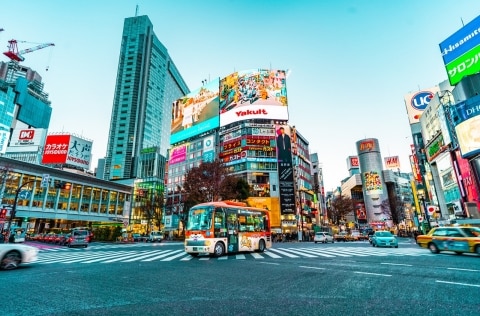The 10 Most Beautiful Places in Japan’s Nara City
Cherry blossoms, adorable deer and ancient shrines and temples are at every turn in Nara, Japan’s first permanent capital. Just 30-minutes by train from Osaka or roughly three hours by high speed train from Tokyo, the city’s manicured parklands, historic architecture and protected landscapes make it one of the country’s most beautiful places to explore.

Nara Park
1/11More than 1200 wild sika deer roam Nara Park, a vast 660-hectare expanse established in 1880 in the middle of Nara City. Considered sacred messengers of the gods, the protected deer spend their days lolling in the field. Rows of cherry trees make the park an ideal viewing spot during sakura (cherry blossom) season from March to April and some of the city's most significant temples, shrines and museums such as the Nara National Museum can also be found throughout the verdant oasis.

Isuien garden
2/11Garden design is a Japanese art-form honed over more than 1000 years. Isuien (meaning “garden founded on water”) is so-named for its tranquil ponds which are fed by the neighbouring Yoshikigawa River. Dotted with tea houses serving matcha green teas and light meals and calm places to sit and reflect, the garden (which is actually comprised of two gardens, one dating to the mid-17th century and the other built in 1899) also has a museum showcasing ancient Chinese and Korean artefacts, including ceramics and bronze seals.

Kohfukuji Temple
3/11Belonging to the powerful Fujiwara family, who had long ties to the Japanese regency, this temple, established in 710CE has been registered as a World Heritage site since 1998. The complex and surrounding areas once contained 150 buildings. Several landmark structures remain, including the 50-metre-tall five-storied pagoda, Japan’s second-tallest wooden pagoda. Built in 730CE (the current structure dates to 1426), the pagoda is undergoing major construction until 2031. The Central Golden Hall was rebuilt in 2018 and the National Treasure Hall houses the temple’s incredible Buddhist art collection.
Experience the Cherry Blossom season in full bloom in Nara City. Visit for more information.
Saho River
4/11The Saho River runs through the centre of Nara and is planted with a magnificent five-kilometre stretch of cherry trees that dye the surface of the water pink in sakura season. They’re believed to have originated from the end of the Edo Period when magistrate Kawaji Toshiakira planted the fragrant boulevard. In springtime, the riverside comes alive at night with the Kawaji-zakura Festival during which lanterns are lit as the sun sets, illuminating the blossoms.
Nara Palace Site Historical Park
5/11In the Nara Period (710CE to 794CE), Nara was Japan’s capital and was known as Heijō-kyo, home of the imperial residence and the seat of government. When the capital was moved to Kyoto in 794, the site of the palace was predominantly used for farming until it was excavated in the 1960s. Reconstructions of the enormous Suzaku Mon gate, former Imperial Audience Hall Daiichiji (Daigokuden) and the East Palace Garden in the 1990s and 2000s provide insight into this historic precinct.
Kasuga Taisha Shrine
6/11Kasuga Taisha Shrine, with its deep vermillion columns that contrast with the surrounding green woods of Mount Kasuga Primeval Forest, is one of Nara’s jewels. More than 2000 stone lanterns line the pathway leading to the shrine, which was established in 768CE, and 1000 bronze lanterns hang from the eaves of the shrine. The lanterns, donated by worshippers, are lit only twice a year for the Mantoro lantern festivals held in early February and mid-August.
Takisaka-no-Michi Path
7/11Leading from the centre of Nara to the village of Yagyu, Takisaka-no-Michi Path is a beautiful cobblestoned trail through pristine Mount Kasuga Primeval Forest. The 12-kilometre path plots a course through land that has been untouched for more than 1000 years, as logging and hunting have been prohibited since 841CE. The journey ends at Shingon Buddhist Enjō-ji temple, founded in 756CE, where you’ll find the temple, a pagoda and Shinto shrines in a late-Heian period (794-1185CE) garden.
Experience the Cherry Blossom season in full bloom in Nara City. Visit for more information.
Todaiji Temple
8/11Todaiji Temple is among the most important historical monuments in Nara. Originally built in 752CE, the enormous wooden Daibutsuden (Big Buddha Hall) was destroyed by fire, twice and rebuilt in 1709. It’s a 20-minute walk from the city centre and houses a 15-metre-tall bronze Buddha statue. Several smaller structures can be found nearby including Nandaimon Gate and Nigatsudo Hall, which offers excellent views of Nara from its balcony.
Naramachi old town
9/11Nara’s former merchant area, Naramachi is home to several well-preserved traditional wooden machiya buildings from the Edo period (1603-1868), characterised by their narrow frontages. Now, they’re occupied by coffee shops, boutiques and restaurants. Koshi-no-ie Residence is a reproduction of a traditional machiya allowing visitors an insight into historic daily life; others include the Naramachi Karakuri Omochakan (mechanical toy museum) and the Nara Kogeikan (craft museum).
Gangoji Temple
10/11UNESCO-listed Gangoji Temple is among Japan’s most ancient. It was originally called the Asuka-dera Temple, built in 596. It became the first Buddhist temple in Japan – known as the Hokoji Temple. When the capital moved to Heijo Kyo (Nara) in 718, so did Hokoji temple, which was rebuilt in its current location and renamed Gangoji. Today, The best-preserved part of the temple is Gokuraku-do (Hall of Pure Land) which, along with the Zen Shitsu (Contemplation Hall), is a designated National Treasure. The Treasure House contains many treasures including the national treasure miniature five-storey pagoda.
Experience the Cherry Blossom season in full bloom in Nara City. Visit for more information.
Image credit: Japan National Tourism Organization
Up Next
11/11













